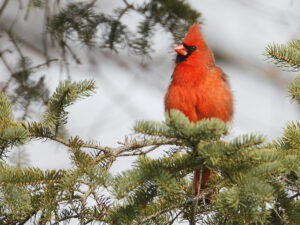The bright red cardinals that bring joy to so many of us are visible and vocal right now, but how much do we really know about them? Thanks to a new addition to NH Audubon’s State of the Birds website, you can find out quite a lot! The new site features all the familiar species you might see in your backyard, plus many birds of conservation interest. Currently over 200 avian species are included with more to come.
The website addition is the brainchild of Dr. Pamela Hunt, NH Audubon’s senior biologist for avian conservation. “This is the first time that NH specific information on most of the species of birds that occur in NH is accessible in one place,” Hunt explains. “It takes you further than a field guide.”
Each species account on the site includes a map of their range in the state, long-term population trends, a seasonal occurrence graph, and stories about the birds relative to New Hampshire.

“The reason I made it is to have this all in one place so that people interested in conservation could learn more about our birds,” says Hunt. “We’ve covered all of the familiar and some of the less familiar birds that occur in the state at some point in their lives – whether they live here year-round, like the Northern Cardinal, or stop in during their migration to more northern locations.”
Data used to create the site is gleaned through decades of information collected from breeding bird surveys, Christmas bird counts, and the Backyard Winter Bird Survey. With data starting in the mid-sixties, some species details go back 50 years!
“The value of looking at long term population trends is that they smooth out local fluctuations, allowing us to prioritize certain species for future conservation efforts,” Hunt states. “This shows us not only the long trends in decline of some species, suggesting the need for more conservation effort, but also the conservation successes like the Peregrine Falcon and Bald Eagle. That is the whole concept of the State of the Birds – evaluating our birds and how we can help them.”

As a complement to the State of the Birds website, this new directory of NH’s birds is easy to navigate with bird species listed alphabetically plus a search tool at the top of each page. “People want to know where their birds are and what is happening to them,” says Hunt. For example, Grackles are 50% less common than they were 50 years ago. According to Hunt, scientists can’t explain the decline, but the data shows us it is happening. A search for Common Grackle reveals that their population in North America nears 70 million. In New Hampshire, you can see large, communal roosts containing up to 100,000 birds. And in certain areas along the coast, they stream to their roost sites in great ribbons across the sky near dawn and dusk. For a deeper dive into their world, the site links to habitat preferences, migration distance (in this case, they are short distance migrators), population status in the state, specific threats they face, and suggestions for conservation actions we can all take.
Another example is the newly common Carolina Wren. In the 1990s they were still rare in most of New Hampshire, but since then have increased dramatically and are now widely seen in the southern portion of the state.
“There are so many great ways to use the new site,” says NH Audubon president Doug Bechtel. “It can help you improve your birding skills and knowledge, quench curiosity about the birds at your feeder, and be a wonderful tool for the classroom.”
What makes it so special, according to Bechtel, is that this resource is uniquely NH Audubon. It is based on decades of NH data and research produced by the best bird science and knowledge, combined with the best technology.
“It’s so easy to use. You don’t need to read a 20-page scientific journal article—it’s all right here.”
Access the site at: https://stateofthebirds.nhaudubon.org/birds-a-z/
The creation effort took a year of data interpretation and writing by Hunt, whose knowledge of NH birds is unparalleled. What drives her efforts? Hunt shares, “I hope these profiles prove useful to anyone curious about the status of our state’s birds and interested in fun ecological stories about them.”
